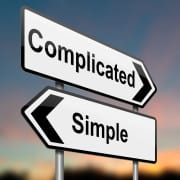Simplicity: where personal and professional meet
One of the rules I keep in mind when writing is that good writing is clear, crisp, and simple. The same rule often applies more generally as well. As Einstein said, “Everything should be made as simple as possible, but not simpler.”
When it comes to managing one’s personal life while maintaining a practice, “simple” is the name of the game. (And this is a good time to note a favorite distinction: “simple” is not a synonym for “easy.”) For instance, it’s much less stressful to prepare a simple dinner — say, a salad with various store-bought toppings and dressing — than it is to prepare a meal that requires numerous ingredients. Likewise, I find that dressing in the morning is much more simple when my clothes are in reasonably good order and my closet not overstuffed. Aspects of life that are more complicated than necessary drain energy.
And the same is true in the office. If my files are a mess and I can’t find anything, I’ll have to stop and launch a search everytime I need a document, and that takes a tremendous amount of energy away from the task at hand. Having a cluttered email box pulls at me because when I check for new messages, my eye is drawn to all of the messages I need to answer or otherwise handle, and slick filing system that put the messages out of sight make my life even more complicated.
Simplicity is especially important when personal and professional life intersect or affect one another. One of my favorite questions to clients working on work/life integration issues is, “What can you stop doing?” Releasing an activity that isn’t productive (in pleasure or in business) is often one of the most simple and most impactful steps to take.
Unfortunately, though, simplifying isn’t always an easy thing to do. An overcrowded, disorganized closet may take hours or even days to get straightened. So, I was delighted to find Simple Living Simplified: 10 Things You Can Do Today to Simplify Your Life on the zenhabits blog. Ideas include:
— making a short list of top priorities (similar to an Absolute Yes list, which I previously discussed in this post);
— simplifying the “to do” list by identifying tasks that can be “eliminated, delegated, automated, outsourced or ignored;” and
— focusing on one task at a time.
And if 10 simplification steps aren’t enough, check the expanded list of the Simple Living Manifesto: 72 Ideas to Simplify Your Life. Any list of 72 items feels unwieldy to me, but it’s worth a skim.




Leave a Reply
Want to join the discussion?Feel free to contribute!